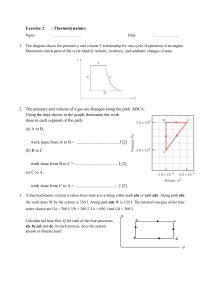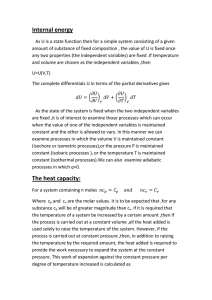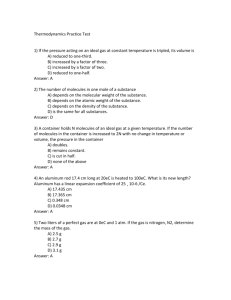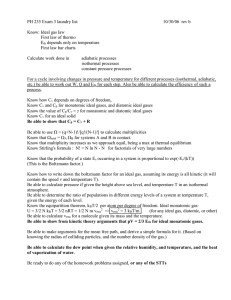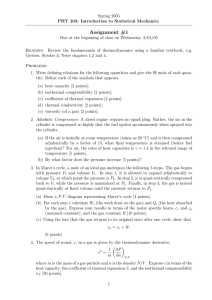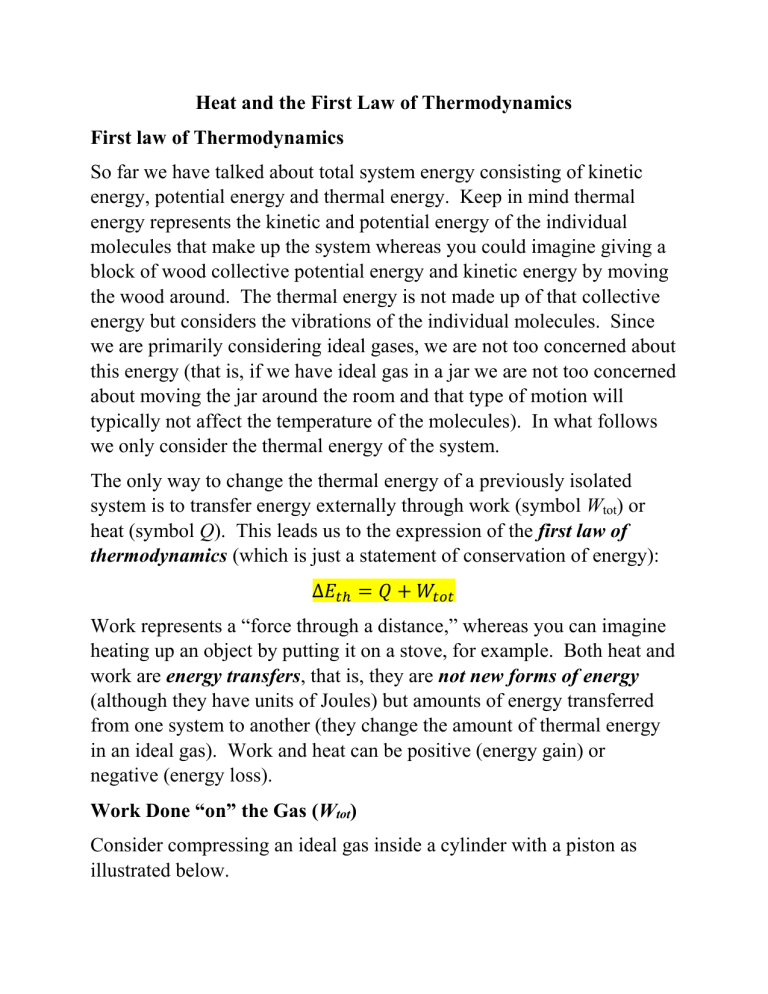
Heat and the First Law of Thermodynamics First law of Thermodynamics So far we have talked about total system energy consisting of kinetic energy, potential energy and thermal energy. Keep in mind thermal energy represents the kinetic and potential energy of the individual molecules that make up the system whereas you could imagine giving a block of wood collective potential energy and kinetic energy by moving the wood around. The thermal energy is not made up of that collective energy but considers the vibrations of the individual molecules. Since we are primarily considering ideal gases, we are not too concerned about this energy (that is, if we have ideal gas in a jar we are not too concerned about moving the jar around the room and that type of motion will typically not affect the temperature of the molecules). In what follows we only consider the thermal energy of the system. The only way to change the thermal energy of a previously isolated system is to transfer energy externally through work (symbol Wtot) or heat (symbol Q). This leads us to the expression of the first law of thermodynamics (which is just a statement of conservation of energy): ∆𝐸𝑡ℎ = 𝑄 + 𝑊𝑡𝑜𝑡 Work represents a “force through a distance,” whereas you can imagine heating up an object by putting it on a stove, for example. Both heat and work are energy transfers, that is, they are not new forms of energy (although they have units of Joules) but amounts of energy transferred from one system to another (they change the amount of thermal energy in an ideal gas). Work and heat can be positive (energy gain) or negative (energy loss). Work Done “on” the Gas (Wtot) Consider compressing an ideal gas inside a cylinder with a piston as illustrated below. If we push the piston down (compress the gas), we do what is called “work done on the gas” Wtot, which is a positive quantity of energy gained by the ideal gas. If we let go of the piston, the ideal gas pushes up on the piston and the work done on the gas is now negative. The ideal gas is now losing energy. Summarizing, for a compression Wtot>0, and for an expansion Wtot<0. Notice volume MUST change in order to have non-zero amount of work done on the gas. Work Done “by” the Gas (W) For the expansion above, the ideal gas is said to do work on its surroundings, W. That is called “work done by the gas” and is positive for an expansion. The work done by the gas is consequently negative for a compression. There is a simple relation between work done “on” the gas vs. work done “by” the gas: Wtot=-W. Summarizing, for a compression W<0, and for an expansion W>0. W will be important when we consider heat engines as it represents the work output of an engine. Calculating Work Imagine pushing the piston down by a differential amount of displacement dy. We expect the work done on the gas will be positive (compression). If the compression occurs with a roughly constant amount of force, we can find the differential amount of work done through the dot product: ⃑ 𝑑𝑊𝑡𝑜𝑡 = ⃑𝑭 ∙ 𝒅𝒓 Where force is downward and equal to the pressure times the crosssectional area of the piston: ⃑𝑭 = −𝑝𝐴𝒋̂ and the displacement of the gas ⃑ = 𝑑𝑦𝒋̂. Notice there is no negative sign molecules is also downward 𝒅𝒓 on the dy because dy is a displacement component and is negative already (dy<0 downward displacement). The dot product gives 𝑑𝑊𝑡𝑜𝑡 = −𝑝𝐴𝑑𝑦𝒋̂ ∙ 𝒋̂ = −𝑝𝐴𝑑𝑦 From the geometry of the small amount of volume displaced The volume of that tiny cylinder is just dV=Ady so dWtot=-pdV. Notice this equation gives positive work for a compression because dV<0 (volume is getting smaller). It also works for an expansion, because dV>0 and dWtot<0 (negative for an expansion). Integrating the differentials on both sides we get the work done on the gas for a finite volume change (compression or expansion): 𝑉𝑓 𝑊𝑡𝑜𝑡 = − ∫ 𝑝𝑑𝑉 𝑉𝑖 Notice that the limits of integration are the initial and final volumes and be careful to include the negative sign. The integral above can be represented on a pV diagram as the area under curve: But you have to be careful of the sign of the work. The work for the last pV diagram is negative because it is an expansion. Area Method To find work done on the gas Wtot using the area method you have to separate the sign from calculating the area: 𝑊𝑡𝑜𝑡 = ±𝐴𝑟𝑒𝑎 𝑢𝑛𝑑𝑒𝑟 𝑐𝑢𝑟𝑣𝑒 You choose a + sign for a compression and a – sign for expansion. Then you calculate the positive area under the curve. Example: find the Wtot for the process on the pV diagram below using both the integral and area method and show that they are equivalent. One way to handle this problem is to add the works for process #1 and #2, Wtot=Wtot1+Wtot2. Using the integral method we get 𝑉𝑓 𝑉𝑓 𝑊𝑡𝑜𝑡 = −𝑝𝑖 ∫ 𝑑𝑉 − ∫ 𝑝𝑑𝑉 = −𝑝𝑖 (𝑉𝑓 − 𝑉𝑖 ) 𝑉𝑖 𝑉𝑓 Notice that Wtot2=0 because the limits of integration are the same (that is, work for an isochoric process is exactly zero). We could also pull the pressure out of the integral because it is constant (isobaric process). Now let’s calculate Wtot2 through the area method. Wtot=0 because there is no area under the curve for an isochoric process. The area method gives Wtot1=+AUC=+lw where the positive length l=Vi-Vf (notice the intial volume is bigger than the final volume) and the width w=pi. Notice that Wtot=-pi(Vf-Vi), the same as the integral result. Cyclic Process A cycle on a pV diagram looks like a loop, like the triangular loop illustrated below. We would like to consider the work done on the gas per cycle (finishing at the same thermodynamic state as starting). Notice this work can be split up Wtot=Wtot1+Wtot2+Wtot3. Notice that Wtot2=0 (isochoric) and that Wtot1>0 (compression) and Wtot3<0 (expansion). Notice that there is more work (area under the curve) for expansion in this case than compression. Thus, we expect the total work per cycle to be negative. Using the area method we get 𝑊𝑡𝑜𝑡1 = +𝑙𝑤 = +𝑝1 (𝑉2 − 𝑉1 ) 1 1 2 2 𝑊𝑡𝑜𝑡3 = − (𝑙𝑤 + 𝑏ℎ) = −(𝑝1 (𝑉2 − 𝑉1 ) + (𝑉2 − 𝑉1 )(𝑝2 − 𝑝1 )) Notice when the two works are added together, the area of the rectangle drops out and we are left with negative the area of the triangle: 1 𝑊𝑡𝑜𝑡 = − (𝑉2 − 𝑉1 )(𝑝2 − 𝑝1 ) 2 In general, for any cycle, the work per cycle is just the area of the shape: 𝑊𝑝𝑒𝑟 𝑐𝑦𝑐𝑙𝑒,𝑡𝑜𝑡 = ±𝐴𝑟𝑒𝑎 𝑜𝑓𝑠ℎ𝑎𝑝𝑒 Where + is for a counter-clockwise cycle and – is for a clockwise cycle. Cycles will be important in our discussion of heat engines and heat pumps. Isothermal Work Solving for pressure in the ideal gas law gives p=nRT/V. If we assume an isothermal process then nRT is a constant. We can then substitute this function into our integral equation for work: 𝑉𝑓 𝑊𝑡𝑜𝑡 = − ∫ 𝑉𝑖 𝑉𝑓 𝑛𝑅𝑇 𝑑𝑉 𝑑𝑉 = −𝑛𝑅𝑇 ∫ = −𝑛𝑅𝑇(ln 𝑉𝑓 − ln 𝑉𝑖 ) 𝑉 𝑉 𝑉𝑖 Where we have pulled out the constant from the integrand. Using the identities lnA-lnB=ln(A/B) and –ln(A/B)=ln(B/A) we have 𝑊𝑡𝑜𝑡 = 𝑛𝑅𝑇 ln 𝑉𝑖 𝑉𝑓 Notice that this equation is good for a compression, because the fraction of volumes Vi/Vf is greater than one, so Wtot is positive (as expected). For an expansion, the fraction of volumes is less than one, so Wtot is negative (as expected). Isochoric Work As discussed previously, there is no area under an isochord so Wtot=0. Isobaric Work The work done on the gas for an isobaric process can be found using the area method (it is the area of a rectangle on a pV diagram). For a general isobaric process, Wtot=-pΔV. Heat When heat energy is transferred to a system, its temperature usually increases in direct proportion to the amount of heat Q added: Q=CΔT, where C is called the heat capacity. More often we deal with the specific heat c of a system defined by Q=mcΔT, where m is the mass. This statement essentially says that if you want to increase the temperature by a certain about, the heat energy required to do this will be greater the larger the mass of the object or the larger the specific heat. Specific heat is a property of a particular material. For example, the specific heat of metal (a good heat conductor) is much smaller than an equal mass of Styrofoam (a poor heat conductor). That means it takes a lot more Q to change the temperature of the Styrofoam. Units of Specific Heat From the specific heat equation, its units are J/kgK. The units can also be listed as J/kg°C because remember that the conversion factor from Kelvin temperature change to Celcius temperature change is just unity. Calorimetry A useful way to determine the specific heat of a substance is through calorimetry. A simple calorimeter is just a cup of water. Suppose we know the mass of the water mw and its temperature Tw. We can also look up the specific heat of liquid water (cw=4190 J/kgK). Suppose also we have a block of mystery material of mass mx and temperature Tx where the material is very hot (that is, Tx>>Tw). We would like to find the specific heat of the metal cx. If we put the material in the water and wait until equilibrium at temperature Tf we notice that heat energy flows from hot to cold. That is Qcold is the positive heat gained by the water and Qhot is the negative heat lost by the material. By conservation of energy we expect Qhot=-Qcold, that is the energy lost by the material is gained by the water. Notice the negative sign ensures that the heats have the appropriate signs for loss and gain. Substituting the heat equations: 𝑚𝑥 𝑐𝑥 ∆𝑇𝑥 = −𝑚𝑤 𝑐𝑤 ∆𝑇𝑤 Substituting the temperatures: 𝑚𝑥 𝑐𝑥 (𝑇𝑓 − 𝑇𝑥 ) = −𝑚𝑤 𝑐𝑤 (𝑇𝑓 − 𝑇𝑤 ) And solve for cx: 𝑐𝑥 = −𝑚𝑤 𝑐𝑤 (𝑇𝑓 − 𝑇𝑤 ) 𝑚𝑥 (𝑇𝑓 − 𝑇𝑥 ) Notice that cx is positive (always for specific heat). Sometimes the calorimeter will include the cup, as the cup gains heat as well. You will have to add the contribution to the cup for Qcold knowing what the specific heat of the cup is. Latent Heat The heat associated with a phase (or state) change of a system is called latent heat. This is the energy to melt or freeze a substance or to boil or condense a substance. It occurs at constant temperature: 𝑄 = ±𝑚𝐿 Where L is called the latent heat (units of L are J/kg) and the + sign is for melting and/or boiling and the – sign is for freezing and/or condensing. Notice if you have water ice at 0°C and you apply the latent heat of fusion you will have liquid water at 0°C (no temperature change). Example: what is the heat energy Q required to change 1g of water ice at Ti=-30°C to steam at Tf=120°C? Part A: heat the ice to freezing temperature 0°C: QA=miciΔTi=(0.001kg)(2090J/kgK)(0°C+30°C)=62.7J Part B: apply latent heat of fusion to melt the ice at 0°C: QB=+miLf=(0.001kg)(3.33x105J/kg)=333J Part C: heat the liquid water to 100°C: QC=micwΔTw=(0.001kg)(4190J/kgK)(100°C-0°C)=419J Part D: apply the latent heat of vaporization to boil the water to steam at 100°C: QD=+miLv=(0.001kg)(2.26x106J/kg)=2260J Part E: heat the steam to 120°C: QE=micsΔTs=(0.001kg)(2.01x103J/kgK)(120°C-100°C)=40.2J The total heat is a sum of all the heats above Q=3114.9J. We can make a plot of the heat added as a function of temperature: Notice that changing the liquid water to steam requires the most heat energy. Steam is very dangerous because it holds a lot of energy! Molar Specific Heat and Thermal Energy Consider the two isotherms on the pV diagram below. Notice that T2>T1 and that there are an infinite number of ways to jump from the cold isotherm to the hot isotherm. Two ways are shown above. Path A is an isochoric (constant volume) process and path B is an isobaric (constant pressure) process. From the last chapter, the only way to change the thermal energy of an ideal gas is to change the temperature. Thus, the change in thermal energy for the two paths are equal: ΔEthA=ΔEthB because the temperature change is the same. From the first law, we can find these changes in thermal energy. We need to find isobaric and isochoric heat first and they are given by molar specific heat: 𝑄 = 𝑛𝐶𝑉 ∆𝑇 𝑎𝑛𝑑 𝑄 = 𝑛𝐶𝑝 ∆𝑇 These equations are only good for isochoric or isobaric processes. The capital C’s in the equation are the molar specific heats for constant volume and pressure. Their units are J/molK. Values will be discussed soon. Now we can find the thermal energies for each path and set them equal to each other. For the isochoric process (A) the first law requires just heat (work is zero): ∆𝐸𝑡ℎ𝐴 = 𝑄 = 𝑛𝐶𝑉 ∆𝑇 For the isobaric process (B) we have ∆𝐸𝑡ℎ𝐵 = 𝑄 + 𝑊𝑡𝑜𝑡 = 𝑛𝐶𝑝 ∆𝑇 − 𝑝∆𝑉 Setting the two equal we get 𝑛𝐶𝑉 ∆𝑇 = 𝑛𝐶𝑝 ∆𝑇 − 𝑝∆𝑉 From the ideal gas law for an isobaric process we can write changes like this: 𝑝∆𝑉 = 𝑛𝑅∆𝑇 And substituting it into our thermal energy equation we get 𝑛𝐶𝑉 ∆𝑇 = 𝑛𝐶𝑝 ∆𝑇 − 𝑛𝑅∆𝑇 Dividing out the nΔT’s we arrive at a very simple relation for the molar specific heats: Cp=CV+R. Another interesting relation deals with the change in thermal energy. Remember that any path from cold to hot isotherm gives the same change in thermal energy so for any ideal gas process: ∆𝐸𝑡ℎ = 𝑛𝐶𝑉 ∆𝑇 Values for Specific Heats For a monatomic ideal gas Cv=(3/2)R and Cp=(5/2)R. For a diatomic ideal gas at room temperature CV=(5/2)R and Cp=(7/2)R. We will see where these come from soon. Shortcut for getting isobaric and isochoric heats The pV diagram below shows an isochoric process followed by an isobaric process. Suppose also that the gas is monatomic: To find the heats for these processes (1 and 2), you might need to know the number of moles and the temperatures. However, there is a shortcut to finding the heats for these processes. For example, for the isochoric process we have Q1=nCVΔT. From changes in the ideal gas law for an isochoric process we have ΔpV=nRΔT or nΔT=ΔpV/R so Q1=CvΔpV/R. Using, for a monatomic gas, CV=(3/2)R we get Q1=(3/2)ΔpV. Likewise, using a similar approach for the isobaric process Q2=(5/2)ΔVp. Summarizing, to get the heat you find the fraction you need, multiply by Δ the thing that changes times the thing that remains constant. Notice if this gas was diatomic instead, the heats would be given by Q1=(5/2)ΔpV and Q2=(7/2)ΔVp. That is, the fraction would change. Notice also that you can tell the signs of the heats. Because the pressure is decreasing Q1 is negative (loss) and because the volume is increasing Q2 is positive (gain). Example: suppose we have a monatomic ideal gas using the previous pV diagram where p2=10Pa, p1=6Pa, V1=5m3, and V2=10m3. Find Q1, Wtot1, Q2, and Wtot2. Q1=(3/2)Δp1V1=(3/2)(6Pa-10Pa)(5m3)=-30J Wtot1=0 (isochoric) Q2=(5/2) ΔV2p1=(5/2)(10m3-5m3)(6Pa)=75J Wtot2=-lw=-(10m3-5m3)(6Pa)=-30J Isothermal Heat The change in thermal energy is zero for an isothermal process. The first law gives ∆𝐸𝑡ℎ = 𝑊𝑡𝑜𝑡 + 𝑄 = 0 This does not mean there is no heat and work, it just means that Wtot=-Q, that is, any heat that goes into a system leaves by work and vice versa for an isothermal process. From what we know about work, Q=nRTln(Vf/Vi) for an isothermal process. Adiabatic Process An adiabatic process is when Q=0. One can imagine this process occurring in an insulated container where no heat can escape. An adiabatic looks steeper than a corresponding isothermal process on a pV diagram because of the equations connecting the initial and final thermodynamic states: 𝛾 𝛾 𝑝𝑖 𝑉𝑖 = 𝑝𝑓 𝑉𝑓 𝛾−1 𝑇𝑖 𝑉𝑖 𝛾−1 = 𝑇𝑓 𝑉𝑓 Where γ is the adiabatic index and is obtained through the molar specific heats γ=Cp/CV. For a monatomic gas γ=5/3 and for a diatomic gas γ=7/5. It’s the adiabatic index (the exponent) that makes the curve steeper than a corresponding isotherm. From the first law of thermodynamics ΔEth=Wtot for an adiabatic process. Since all ideal gas processes have the same change in thermal energy, Wtot=nCvΔT for an adiabatic process only. Adiabatic Free Expansion A very special type of adiabatic process is the adiabatic free expansion. Imagine two insulated chambers connected by a thin membrane as illustrated below. The process is adiabatic because no heat can flow (insulated). In one chamber there is a vacuum and the other ideal gas. Imagine poking a hole in the membrane. The molecules are moving and eventually the gas will fill the entire chamber (the “AFTER” case). From the first law we have ΔEth=0, that is, there is no heat OR work. There is no work because the gas molecules don’t push and move anything up (like a piston). Since there is no change in thermal energy, there is no change in temperature, so this expansion is not only adiabatic but isothermal also! Summarizing, for the adiabatic free expanstion, ΔEth=0, ΔT=0, Wtot=0, and Q=0. Notice also that by p=nRT/V, since nRT is constant, if the volume doubles the pressure decreases by half. Another way to think about the fact that this is an isothermal process is that poking a hole in the membrane does not change the rms speed of the molecules. We know that temperature is only a function of rms speed, so if the speed does not change the temperature does not change. Degrees of Freedom and Equipartition Recall that the average kinetic energy per molecule was only a function of the rms speed of the molecules. The expression below is only true for a monatomic gas (or a gas that behaves like a monatomic gas): 1 3 2 𝑚𝑣𝑟𝑚𝑠 = 𝑘𝐵 𝑇 2 2 We can write out the rms speed in terms of its components: 1 3 2 2 2 𝑚(𝑣𝑟𝑚𝑠,𝑥 + 𝑣𝑟𝑚𝑠,𝑦 + 𝑣𝑟𝑚𝑠,𝑧 ) = 𝑘𝐵 𝑇 2 2 Notice in a random distribution all the rms components are equal and requires that each one contributes exactly 1/2kBT to the kinetic energy per molecule. This is called equipartition of energy, that is, each degree of freedom contributes exactly 1/2kBT to the average kinetic energy per molecule. The symbol for degree of freedom is f. A degree of freedom is a “way of moving”. Notice there are f=3 degrees of freedom for a monatomic gas. That is, the individual gas molecule (which is an atom) can move in 3 ways (x, y and z direction). More complicated gases (like diatomic gases) have more ways of moving (at certain temperatures) and we have to amend our energy equations to account for extra degrees of freedom: 𝑓 𝑘 𝑇 2 𝐵 𝑓 = 𝑁𝐾𝑎𝑣𝑔 = 𝑁𝑘𝐵 𝑇 2 𝐾𝑎𝑣𝑔 = 𝐸𝑡ℎ Diatomic Gas A diatomic gas molecule (like diatomic nitrogen) consists of two gas molecules connected by a chemical bond. The bond can produce extra degrees of freedom because at higher temperatures, motion about the bond can be created (rotations and vibrations). Typically, for a very cold diatomic gas (10’s of Kelvin) f=3, and it acts like a monatomic gas. For temperatures closer to room temperature (around 300K) f=5, the molecule can start to rotate about two axes. For even higher temperatures (around 1000K) the molecules can start to vibrate in two ways (slow and fast) and f=7. Molar Specific Heats and Adiabatic Index From our amended thermal energy equation we can convert to the molar version of changes in thermal energy: ∆𝐸𝑡ℎ = 𝑓 𝑓 𝑁𝑘𝐵 ∆𝑇 = 𝑛𝑅∆𝑇 = 𝑛𝐶𝑉 ∆𝑇 2 2 The last equation remember we found was good for ANY ideal gas process. Comparing the two equations to the right, we see that CV=(f/2)R and from that we can get Cp, that is, Cp=CV+R. Thus, for a monatomic gas we get CV=(3/2)R and Cp=(5/2)R. Likewise, for a diatomic gas we get f=5 so CV=(5/2)R and Cp=(7/2)R. The molar specific heats also give us the adiabatic index γ=Cp/CV. So γ=5/3 for monatomic and γ=7/5 for diatomic (at room temperature). Conduction of Heat We’ve seen that heat energy moves from hot to cold and, when you heat something up, it results in a temperature change. This movement is called “conduction”. Conduction is described by the following power formula: 𝑃= 𝑄 𝐴 = 𝑘 (𝑇ℎ𝑜𝑡 − 𝑇𝑐𝑜𝑙𝑑 ) ∆𝑡 𝑙 Where Q is the heat that flows from one system to the other, A is the cross sectional area of the “path” that the heat flows, l is the distance the heat travels, k is called the “thermal conductivity,” and Δt is the time it takes for the heat to flow. Notice, you get more heat in a smaller amount of time for a bigger temperature difference, also more heat can flow if the A is bigger (a bigger channel for the heat to flow). More heat can flow for a bigger thermal conductivity, which is a property of various materials. Finally, less heat per unit time flows if the path is longer as it takes a longer time for the energy to reach the object. Radiation Light sources, like a light bulb or the Sun radiate energy away from the source through the Stefan-Boltzmann law: 𝑃= 𝑄 = 𝜎𝜖𝐴𝑇 4 ∆𝑡 Where σ=5.6703x10-8 W/m2K4 is known as the Stephan-Boltzmann constant and ε is called emissivity which is a number from 0 to 1, if ε is close to 1 the source is a good emitter AND absorber, that is it can absorb radiation just as good as it can emit it (a dark object has a high emissivity, for example).
